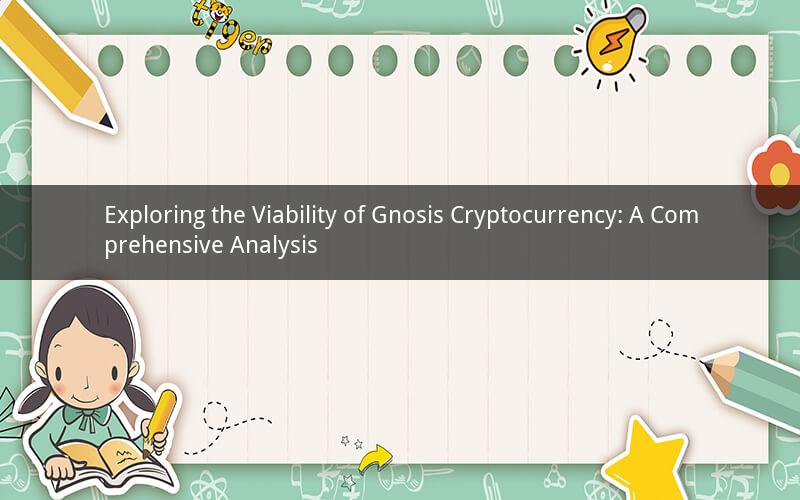
Introduction:
Gnosis cryptocurrency, often referred to as GNO, has gained significant attention in the cryptocurrency market. This article aims to delve into the viability of Gnosis by examining its features, technology, market trends, and potential challenges. By understanding these aspects, we can assess the potential of Gnosis to thrive in the highly competitive cryptocurrency landscape.
1. Understanding Gnosis Cryptocurrency:
Gnosis is a decentralized prediction market platform built on the Ethereum blockchain. It allows users to create, trade, and settle predictions on a wide range of events. The platform operates through a native token called GNO, which is used to pay for transaction fees, reward participants, and provide governance rights.
2. Gnosis' Unique Features:
Gnosis offers several unique features that contribute to its viability:
a. Decentralized Prediction Markets: Gnosis provides a decentralized platform for creating and trading predictions on various events. This feature enables users to participate in markets without relying on centralized exchanges or intermediaries.
b. Smart Contracts: Gnosis utilizes smart contracts to automate the creation, trading, and settlement of predictions. This ensures transparency, security, and efficiency in the prediction market ecosystem.
c. GNO Token: The GNO token serves multiple purposes within the Gnosis ecosystem. It is used to pay for transaction fees, reward participants, and provide governance rights. This dual-purpose token enhances the utility and demand for GNO.
3. Market Trends:
To assess the viability of Gnosis, it is crucial to consider the broader market trends:
a. Growing Interest in Decentralized Finance (DeFi): The rise of DeFi has created a growing demand for decentralized platforms that offer innovative financial services. Gnosis, being a part of the DeFi ecosystem, benefits from this increasing interest.
b. Increased Adoption of Blockchain Technology: Blockchain technology continues to gain traction across various industries. The adoption of blockchain in prediction markets further enhances the viability of Gnosis.
c. Regulatory Environment: The regulatory landscape for cryptocurrencies is evolving. While some countries have imposed strict regulations, others have shown a more lenient approach. Gnosis' compliance with regulatory requirements will play a crucial role in its viability.
4. Potential Challenges:
Despite its promising features and market trends, Gnosis faces several challenges that could impact its viability:
a. High Gas Fees: Ethereum's high gas fees can discourage users from actively participating in Gnosis prediction markets. This challenge needs to be addressed to maintain user engagement.
b. Competition: The cryptocurrency market is highly competitive, with numerous prediction market platforms vying for market share. Gnosis needs to differentiate itself and offer unique value propositions to attract and retain users.
c. Scalability: As the number of users and transactions increases, scalability becomes a critical concern. Gnosis needs to ensure that its platform can handle high transaction volumes without compromising on performance.
5. Conclusion:
In conclusion, Gnosis cryptocurrency has several factors that contribute to its viability. Its unique features, growing interest in DeFi, and increasing adoption of blockchain technology present promising opportunities. However, challenges such as high gas fees, competition, and scalability need to be addressed to ensure long-term success. By continuously evolving and adapting to market dynamics, Gnosis has the potential to become a significant player in the cryptocurrency space.
Questions and Answers:
1. What is the purpose of the GNO token within the Gnosis ecosystem?
The GNO token serves multiple purposes within the Gnosis ecosystem. It is used to pay for transaction fees, reward participants, and provide governance rights.
2. How does Gnosis ensure transparency in its prediction markets?
Gnosis utilizes smart contracts to automate the creation, trading, and settlement of predictions. These smart contracts are transparent and can be audited by anyone, ensuring transparency in the prediction market ecosystem.
3. What are the potential benefits of using Gnosis for decentralized prediction markets?
Using Gnosis for decentralized prediction markets offers several benefits, including increased security, transparency, and efficiency. Users can participate in markets without relying on centralized exchanges or intermediaries, providing a more decentralized and user-centric experience.
4. How does Gnosis differentiate itself from other prediction market platforms?
Gnosis differentiates itself through its unique features, such as decentralized prediction markets, smart contracts, and the dual-purpose GNO token. These features provide a more secure, transparent, and user-centric platform compared to traditional prediction market platforms.
5. What challenges does Gnosis face in terms of scalability?
Gnosis faces scalability challenges due to the increasing number of users and transactions on its platform. To address this, Gnosis needs to ensure that its platform can handle high transaction volumes without compromising on performance, potentially by exploring layer 2 scaling solutions or other scalability solutions.